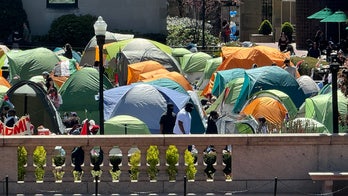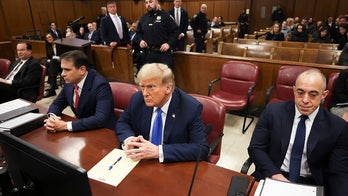Ponder this for a moment.
The same group of people who can't pass a farm bill, can barely approve a transportation bill and narrowly avoided shutting down the government could have a big assignment come early January: selecting the next President of the United States.
You heard it right.
It's conceivable the U.S. House of Representatives could choose the next president.
The polls are clenched in Ohio, Virginia, New Hampshire, Colorado, Wisconsin, Nevada, Iowa, Florida and North Carolina. And multiple scenarios are emerging where it may be up the House of Representatives to tap either President Obama or Mitt Romney as president.
As we start our descent, please return your seat backs and tray tables to their full, upright position. Make sure your seat belt is securely fastened. Because this political landing might get a little choppy.
The House of Representatives could be asked to decide something that couldn't be settled by hundreds of millions of dollars of advertising spread across more than a year of campaigning. That's to say nothing of the popular ballots of 130 million people and 538 individuals casting votes in the electoral college.
In baseball, a tie goes to the runner. In the electoral college, it goes to the House. The Constitution says so.
It works like this: Article II, Section 1 of the Constitution requires the House of Representatives to pick the president if no candidate attains the clear majority of the electoral college. This is known as the "contingent vote," traditionally taken early in the year after a presidential election. The newly-constituted House votes on this. But in the 19th Century, personnel from the old, outgoing House was the body that got to do the choosing.
The House has only gotten a crack at naming a president twice. In 1800, the electoral college was knotted at 65-65, pitching the presidential election into the House of Representatives. In that instance, the House tapped Thomas Jefferson as president over Aaron Burr - on the 36th ballot. Lawmakers voted each day between February 11 and February 17, 1801. The election of 1800 remains the only tie ever reached in the electoral college.
In 1824, four candidates split the electoral vote: Andrew Jackson, John Quincy Adams, William Harris Crawford and, ironically enough, then-House Speaker Henry Clay of Kentucky. But the House only considered Jackson, Adams and Crawford for president. The House swiftly elected Adams on the first ballot on February 9, 1825.
Like 1960, 1968, 1976, 2000 and 2004, 2012 is shaping up to be an exceptionally tight election year. But it's the potential distribution of the electoral vote in nine to ten battleground states which may trigger not one but as many as four numerical contingencies where neither President Obama nor Mitt Romney score the magical 270 electoral votes to become president. Instead, these scenarios have them deadlocked at 269-269.
Here are the possible electoral models that produce a tie in the swing states:
In algorithm number one, Mr. Obama wins Wisconsin, Ohio and New Hampshire while Romney captures Florida, North Carolina, Virginia, Iowa, Colorado and Nevada.
Algorithm number two sees the president winning Colorado, Wisconsin and Virginia with Romney taking Nevada, Iowa, Ohio, North Carolina, New Hampshire and Florida.
Algorithm number three is where President Obama is victorious in Colorado, Wisconsin and Virginia as Romney pockets Florida, North Carolina, Ohio, Iowa, Nevada and New Hampshire.
And then there's algorithm number four. This one gets dicey. Both Nebraska and Maine aren't winner-take-all. Those states distribute their electoral vote based on which candidate wins which Congressional district. For instance in 2008, Mr. Obama lost Nebraska. But he won the Congressional District held by Rep. Lee Terry (R-NE). So the president secured one of Nebraska's five electoral votes.
Nebraska isn't an issue this time around. But Maine could be. Rep. Michael Michaud (D-ME) is expected to win re-election in his district covering northern Maine. It's thought that Romney could carry Michaud's home turf, awarding the GOP nominee one of Maine's four electoral votes.
So algorithm four has the president winning Nevada, Colorado and Ohio and the Congressional district represented by Rep. Chellie Pingree (D-ME). Meantime, Romney has Iowa, Wisconsin, Virginia, Florida, North Carolina, Virginia, New Hampshire and Michaud's Congressional district.
All are realistic scenarios which get them to 269-269.
Now there's still one step before the House would conceivably have to jump to it.
In early January, the House and Senate will convene in a Joint Session of Congress to count the electoral vote certificates from each state. Those who cast electoral votes are supposed to represent the popular votes of their states. In other words, if one candidate wins Nevada, then four electors are expected to cast their votes for the person who carried the state. But "faithless electors" sometimes emerge. They vote for someone else. But if there's a 269-269 tie, the entire enterprise moves to the House.
Still, it gets more complicated.
The House then elects the new president based on how a majority of state delegations vote. In other words, one state, one vote. For instance, Rep. Don Young (R-AK) is the only House member from Alaska. He makes up the entire House delegation. Presumably, Young would vote for Mitt Romney. Democrats hold a significant advantage in California's 53 House seats. So it's expected that California would vote for President Obama.
The key here is that the winning candidate must secure 26 of the 50 state delegations in the House.
With the election more than two weeks away, it's not possible to know the precise breakdowns of state Congressional delegations in the Congress that convenes in January. But it appears that Republicans should control 28 delegations with Democrats only slated to have the majority in 12. The other 10 states are toss-ups. For instance, Colorado has seven House members. Four are Republicans and three are Democrats. However, Democrats are trying to unseat both Reps. Mike Coffman (R-CO) and Scott Tipton (R-CO). By the same token, Rep. Ed Perlmutter (D-CO) faces a challenging re-election bid. So it's unclear which party will have a majority in that delegation. Other states with fuzzy majorities are Nevada, Arizona, Minnesota, Wisconsin, Michigan, New Hampshire, Rhode Island, New Jersey, and perhaps Illinois. Some like New Hampshire, Rhode Island, New Jersey and Nevada could have splits between Democratic and Republican House members.
Regardless, there should be a GOP majority in the House that puts Mitt Romney in the driver's seat if the electoral college is a tie.
There are lots of ways to break ties in sports. Baseball tacks on additional innings. Football adds a period. If one team scores on its first possession, it wins the game. But if the team only kicks a field goal, the other team gets the ball. The National Hockey League reduces the number of players on the ice for a short overtime period and then resorts to a shootout. All of these situations unfold regularly in sports. Still, this tiebreaker is rarified air in the American political experience.
An electoral college tie probably won't happen. But if it does...




